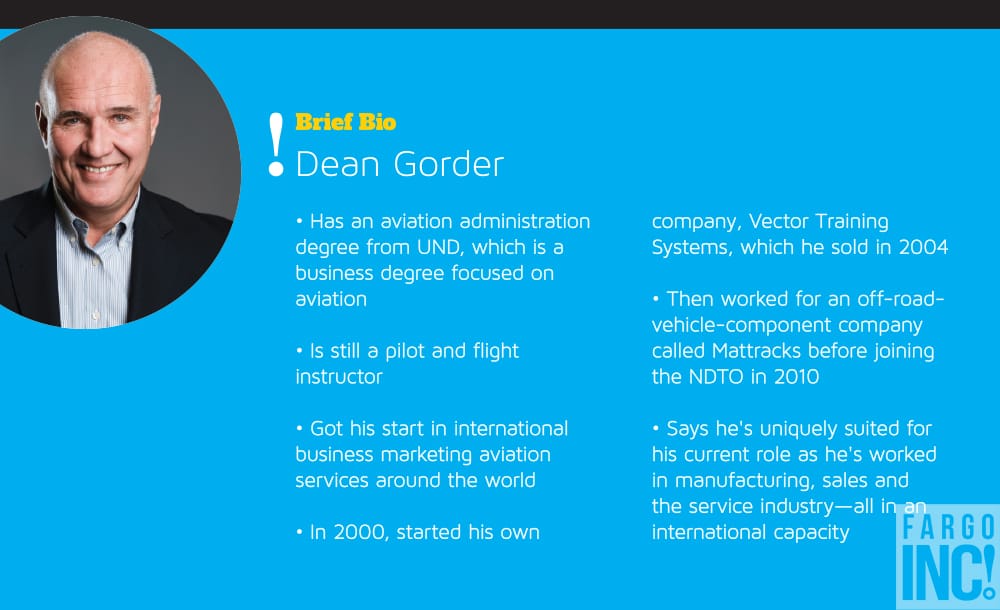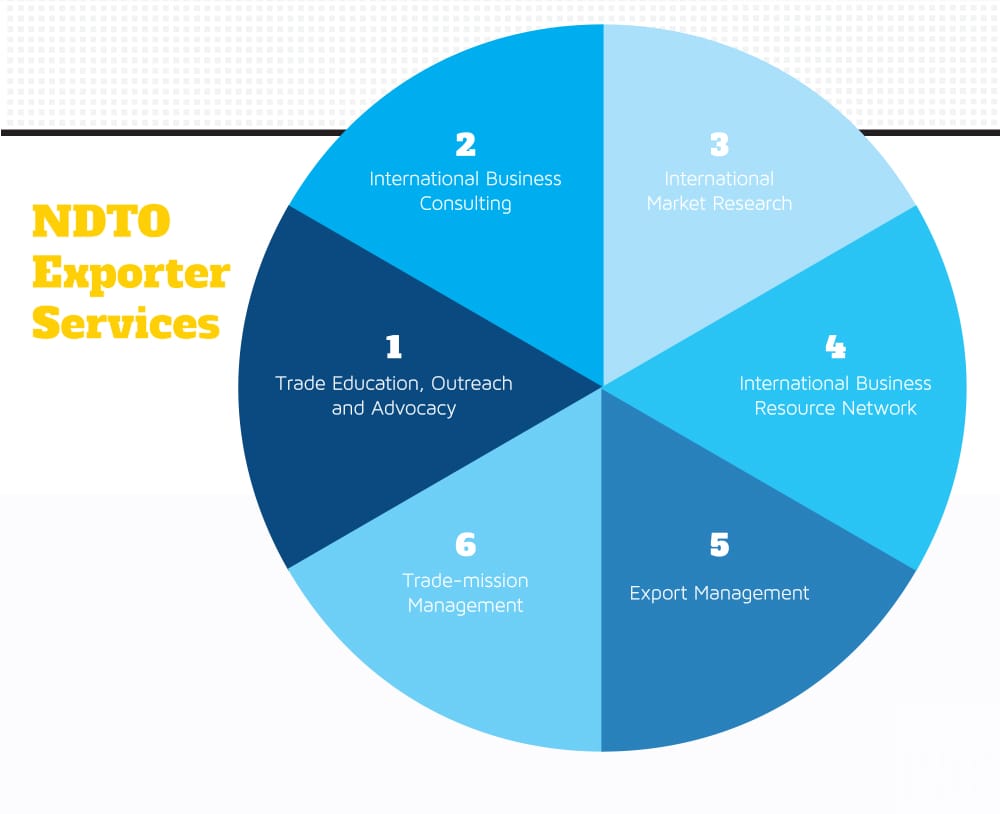Whether you’re a veteran of international trade or aren’t sure if your company is ready to take the leap, here we help you learn a little more about North Dakota’s official liaison to the world marketplace.
Q&A
Ballparking it, what percentage of your member-clients are first-time exporters and what percentage are more established traders?
Dean Gorder: Not an easy answer for that one. A majority of the core companies that we work with are established exporters, but we regularly get contacted by first-timers.
We’re a fairly unique organization. We’re not part of the state. We’re a public-private partnership that is funded, in part, by the state. The balance of our revenue is generated through membership fees, service fees, and grants, which are mostly federal but can also be on the state level.
Because the state provides money to us, we will never turn a North Dakota company away. Anyone that calls us, we’ll work with them.
Typically, what happens is that as an exporter gets more into it and gets a little more serious about it, that’s when we’ll say, “If you really want to become an exporter and you want to do it for the long haul, we suggest that you join us and take advantage of all the services.”
“All the services” being…?
Gorder: So they pay us $5,500 for a 2-year membership. If they use all the services, they get every penny of that back. And people say, “Well that’s silly. Why don’t we just buy them as we go?” And to that I say, “Okay, so six months from now, if I call you and say we have this class and you should be at it, are you going to be too busy? Are you sure you’re going to want to spend the money at that time?
“Tell me now if you’re committed to this. If you’re committed, join us and we’ll continue to offer these services to you.”
We get you on our mailing list, and you get more involved. One of the key elements for these exporters is the networking opportunities that we provide them. That’s really how they learn. We give them the basics, but they plug in and they start meeting the other companies, and there’s a lot of interaction that goes on among the export community—just like any other niche.

What industries do you work with most?
Gorder: The largest is commodities. But it’s not GMO soybeans and corn. It’s non-GMO soybeans and it’s the pulse crops: peas, lentils, chickpeas, dry beans and flax. Things that that aren’t monopolized by the big companies.
With the large-scale commodities—corn, soybeans and wheat—we do get requests. Somebody will say, “We want to buy a shipload of wheat.” We can’t even do it. All the port facilities are owned by one of those big companies, all the ships are owned by one of those big companies. So we don’t go there at all.
They’re dealing in shipload quantities of stuff, and they’re amalgamated loads from all over the US. We really focus on something that’s produced here, packaged here and shipped from here.
The second-biggest industry for us is ag-machinery manufacturers. And construction as well. And that’s both new equipment manufactured here—a Summers Manufacturing, a Superior Grain Bins out of Kindred, companies like that. And then there’s also the RDOs, Brandts and Titans that resell a lot of used equipment out of North Dakota or out of the upper Great Plains to points around the world.
Any industries that might surprise people?
Gorder: A pretty big area that a lot of people don’t think of is education. It’s a fairly major export out of North Dakota. You look at UND and NDSU, and they have a lot of foreign students.
While it’s typically not the purpose of our trade missions, any time we’re in another country, we do take that opportunity. There are people from UND and NDSU who have traveled with us to events. It’s to market the universities to potential students who would come here.
Then there are a lot of other companies—Intelligent InSites here in Fargo, for instance—they’re a member of the Trade Office. They’re selling software, but they’re really selling a service. The software is part of the overall service. A company like Weather Modification, Inc. up at the airport. They’re a pretty major exporter.
There’s just a whole variety of—I don’t want to call them one-offs, but they’re their own industry.
There’s a company up at the airport, Dakota Air Parts, that basically scavenges used helicopters and refurbishes the parts and sells them all over the world. It’s a very successful company, but they don’t market anything in the US. They’ll go take a broken-down Huey out of some jungle somewhere, bring it back here, pull all the important pieces, refurbish them and sell them.
The NDTO focuses entirely on the exports side of things, right?
Gorder: Yes, thats about 95 percent of what we do. Though we will help problem-solve for an importer.
One individual in our office is a licensed customs broker. So if company x—let’s say it’s WCCO Belting out of Wahpeton (N.D.). They import a lot of their raw materials to make their conveyor belts.
If they have an issue on the imports side, they will still contact us, and we’ll help them troubleshoot it. Even though that’s not our focus, if they have a specific issue, we’ll help them work through it.

What role do international sales and trade play in the diversification and modernization of the North Dakota economy?
Gorder: When you look at North Dakota—whether it be oil, commodities or product services—we always produce more than we consume. If you’re Xcel Energy or Minnkota, you sell it to Minnesota. If you’re a farmer, you sell it to wherever the market is—that can be China, that can be wherever. If you’re Intelligent InSites, your market within the US is defined. There’s a lot of competition, but you can go to Singapore, you can go to Norway, you can go to Saudi Arabia. You can go to all these other markets.
To really sum it up, 95 percent of all the consumers in the world live outside the US. So without active outreach and really promoting and pushing North Dakota companies to participate in the global economy, North Dakota will stagnate.
What should the state of North Dakota do to support existing export companies and groom new-to-export companies?
Gorder: This one is a bit self-serving, but I think that providing access to expertise is the key element there. There has to be some place to go, whether it be the Trade Office or the (North Dakota) Department of Agriculture does it to a degree. We tie very tightly to U.S. Commercial Service. Then, through the Department of Ag, we use what’s called the Foreign Ag Service, which is part of the USDA.
So there is this existing network, but how do you connect the producer in Garrison, N.D., to any one of those resources? There has to be a bridge there. To me, somebody within the state has to be tasked with and funded to provide that link from the producer or the packager or the manufacturer in North Dakota to the global market.

North Dakota is a leading producer of many different commodities. What can be done to ensure that the producers and processors of these commodities can get their products to market in a cost-effective manner to effectively compete with other producing regions?Gorder: The key to that one is transportation. If you’re sitting in Fargo and you build a product or grow a product, and you have a customer in—pick any point in the world. How do you get it from Fargo to that point in the world? It’s a huge issue.
Back in the ‘80s, the grain industry in North Dakota and the railroads came up with a shuttle-train system. You’ve probably seen many of them. They’re 150 cars long and they pull an empty train to a grain elevator. If you notice, the small country elevators are gone so now all the elevators have the capacity to load one of these unit trains.
Empty train pulls in, they can fill it in five or six hours, train pulls out, and it’s on its way to Montreal, New Orleans, Seattle, gets on a ship and out it goes.

Most of the products from the companies we deal with don’t go in the same method. Many of them are containerized. Right now, the closest point to get a container and drop off a container is Minneapolis. Not efficient.
Unless you’re near Minneapolis or you’re near Chicago or you’re near Denver—any of the larger metro areas that have good container service—all the manufacturers and producers here are at a disadvantage. So we’ve been working quite diligently on the issue for the last several years.
Minot now has a facility. It’s called North Dakota Port Services. And we have been down to Fort Worth (Texas), we’re lobbying the railroad, we’re lobbying the steamship lines because they, in essence, own those containers. And our goal is for all North Dakota producers to have not only good container service but at competitive prices.
That, to me, will make or break a lot of the manufacturing and specialty commodity companies that are trying to export their product. Otherwise, it’s going to cost you $700 or $800 to drive down to Minneapolis, load up an empty container, haul it up here and haul it back to Minneapolis.

NDTO Exporter Services
1. The NDTO offers a program called “Export Tech,” where real-life companies will come in—one full day per month for three consecutive months—and the companies actually get trained and coached on how to develop a market plan for a new market.
Some are new-to-exports, some are experienced, but as Gorder explains, it really helps them refine the process of identifying and attacking the international marketplace.
“Most of the content is provided by experts in the field,” he says. “So we bring in bankers and lawyers and contract experts so that participants are getting real-world information.”
“It’s much more hands-on than a typical course. The lawyer who’s up in front of the class that day—we use some from Fargo and some from Minneapolis—it’s very likely they just got back from China or Russia.”
3. The NDTO has a full-time staff member who works exclusively in this area.
Gorder explains the benefits of that.
“If you think of our member population, some of them are large companies like an RDO, but many more of them are relatively small companies,” he says. “If you’re a small company, you look at the resources you have available to you.
“What we do is we pool all those small companies together, they pay us a membership fee, and we go out and buy software packages that the smaller companies could never or would never buy on their own because they’re expensive. They can also call us, give us the parameters that they’re looking for, and we can actually go in and do market research for them.”
5. To illustrate the Trade Office’s export-management services, Gorder recalls a recent issue they resolved at a shipping port in Eastern Europe.
“There was a company from western North Dakota that was shipping some cattle equipment into Kazakhstan,” he says. “They used the port in Riga, Latvia, and it got stuck in the port. Now, all of a sudden, you’ve got an issue because the buyer’s not going to pay in full until they have the equipment, and the seller was having difficulty getting it through the port of Riga. So they called me.
“I just called the shipping company directly, and what had happened is there was confusion on how the documents were supposed to be communicated. They had sent me the contract so I looked at it and I said, ‘Okay, there’s a Telex number.’ ‘Oh, jeez, we missed that.’ So they Telexed the information to that number and within a day, it’s up.
“The executive I was working with just didn’t know what questions to ask, but they can contact us, and somebody in this office has usually seen it before. It at least gives you a place to start.”
6. Perhaps the highest-profile of everything the Trade Office does, Gorder and his team routinely lead trade missions around the world—to Egypt, Israel, China, India, and Colombia, just to name a few. They’re responsible for organizing meetings, doing background research and understanding who the players are in a given industry.
Gorder explains that it’s about more than just going to the countries, though.
“One of the key elements when you go on one of these outbound trade missions is that you get them to come back to the state,” he says. “So we do reverse trade missions, and then at each Big Iron, we do a large reverse trade mission. This year, I think we had about 125 foreign buyers from 11 different markets.
“The whole point of that is that, in the modern era, we get very used to emailing and calling and we think that’s good enough. Many points in the world still really require a face-to-face. You have to get to know somebody. We’ve found that the people, the business style and the hospitality of our region are some of the biggest selling points we have. People, when they leave here, go, ‘It’s just a comfortable place.'”
North Dakota Trade Office (NDTO)
ndto.com
811 2nd Ave. N, #284, Fargo
701-231-1150








